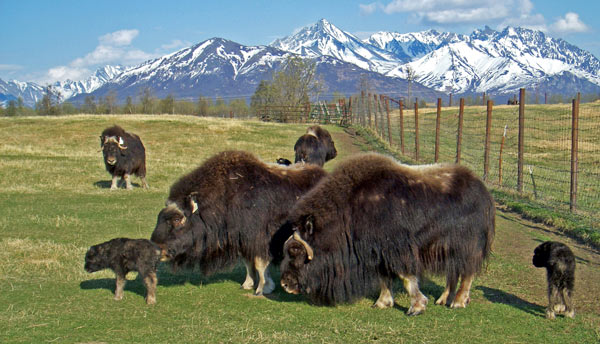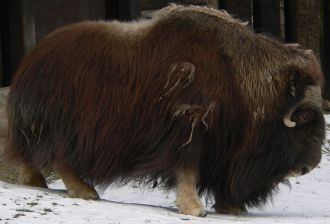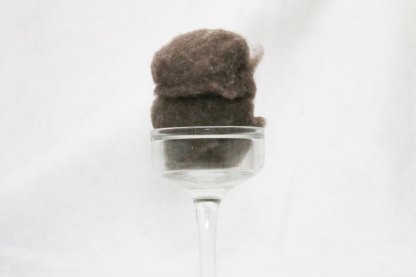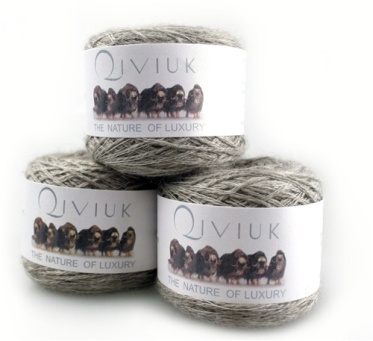Muskox and Qiviut

Muskox is the most misleading name for creatures in the fiber world. Named “Musk” for the distinctive smell of associated with them; they have no musk glands. Nor are Muskox closely related to oxen or cattle of any kind they are more closely related to sheep and goats. They are the largest Caprinae (species including Rocky Mt Goat and Mouflon-ancestor to domestic sheep). Why are they closer to goats and sheep you might ask, because of the clear visual differences between sexes particularly in the horns. While both sexes have horns only the males have the helmet like horn bone or “boss,” that give muskox such a distinct feature.
Muskox are one of the few surviving Pleistocene megafauna in North America, yet they were once hunted to extinction in Alaska. The current population were imported from Greenland in 1931 with 34 animals. There have been longstanding herds of muskox in Canada, Greenland and Northern Siberia.

Muskox have 4 distinct fiber types. Skirt hairs hang nearly to the ground, then there are shorter guard hairs, intermediate fine hair, and the renown Qiviut.
Qiviut, qiviuq, or qiveut are all Inukitut words commonly used to refer to the wool or down of a muskox. It is often considered the gold in the fiber world. With current market prices it is cheaper to buy a gram of silver than that of qiviut. Can it really be called the finest, warmest fiber? There is some argument about it but it is one of the finest fibers and Qiviut protects muskox from -100°F(-73°C), furthermore moisture doesn’t condense on qiviut keeping it from freezing without immersion.

About the fibers:
Skirt hair is the hair that is see hanging nearly to the ground on the animal. There are different textures to the mane, beard, and blanket. It is the coarsest of the fibers traditionally used to make ropes. Then there are the guard hairs which are shorter than skirt hairs and cover the entire body of the then animal. Underneath the guard hairs are intermediate fine hair and qiviut. Both intermediate hairs and qiviut are fine and soft, the intermediate hairs are straighter and thicker, but often still considered part of the qiviut.
The guard hairs have to be removed, generally by hand to full appreciate the qiviet, however a patience spinner with time to spare can also pick the intermediate hairs out to spin separately.

Qiviut is groomed from the animal as it sheds, which with its standing as a protected animal found in reserves in most counties adds to its cost.
- Fleece 5-8 lbs with a 80-88% yield
- Qiviut down ½ – 6 inches
- Intermediate straight hair ½ – 6 inches
- Guard hair ¾ -6 ½ inches
- Skirt hair- up to 24 inches
Qiviut:
Generally considered to be the finest, softest, lightest, and warmest fiber available. It has no scales and therefore cannot felt, likewise it will not shrink. When washed spun fibers will full. The fiber also has no crimp, and no fiber memory, it will stretch like alpaca and never return. Qiviut can pill when given constant abrasion, due to the shortness of the fibers. So no qiviut socks or mittens. Nor should it be used for under layers where it will be rubbing against fibers. It’s micron count can be as low as 10 and as high as 20, becoming coarser as the animal ages. Farmed qiviut seams to grow slightly finer fibers around 14-16.5 microns, while wild averages 17-18 microns.

Qiviut is often blended with cashmere for “economy.” Funny to think that blending something with cashmere could make it cheaper.
Qiviut is full of silvery gray tones to gray brown, but rarely the same color on the same animal twice. Nutristion, weather, age (older the lighter) all affect the colors of the fiber. The fiber can be over-dyed to change the colors but bleaching weakens the fiber and make it wear considerably faster.

Spinning: Spin either from fluff or card with cotton cards, spin fine as it is an excellent insulator, and remember that generally the fibers are very short.

Knitting: While qiviut has loft and some bounce it has no fiber memory, and will likely sag, plan this into you piece, it works brilliantly with lace works blooming into the openings so keep your pattern simple.
The Muskox photos with names are animals looking for sponsorship provided by The Musk Ox Farm – Palmer Alaska a non-profit dedicated to keeping the muskox going for many a more year.
